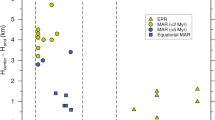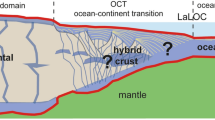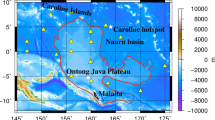Abstract
The location and degree of material transfer between the upper and lower mantle are key to the Earth’s thermal and chemical evolution. Sinking slabs and rising plumes are generally accepted as locations of transfer1,2, whereas mid-ocean ridges are not typically assumed to have a role3. However, tight constraints from in situ measurements at ridges have proved to be challenging. Here we use receiver functions that reveal the conversion of primary to secondary seismic waves to image the discontinuities that bound the mantle transition zone, using ocean bottom seismic data from the equatorial Mid-Atlantic Ridge. Our images show that the seismic discontinuity at depths of about 660 kilometres is broadly uplifted by 10 ± 4 kilometres over a swath about 600 kilometres wide and that the 410-kilometre discontinuity is depressed by 5 ± 4 kilometres. This thinning of the mantle transition zone is coincident with slow shear-wave velocities in the mantle, from global seismic tomography4,5,6,7. In addition, seismic velocities in the mantle transition zone beneath the Mid-Atlantic Ridge are on average slower than those beneath older Atlantic Ocean seafloor. The observations imply material transfer from the lower to the upper mantle—either continuous or punctuated—that is linked to the Mid-Atlantic Ridge. Given the length and longevity of the mid-ocean ridge system, this implies that whole-mantle convection may be more prevalent than previously thought, with ridge upwellings having a role in counterbalancing slab downwellings.
This is a preview of subscription content, access via your institution
Access options
Access Nature and 54 other Nature Portfolio journals
Get Nature+, our best-value online-access subscription
$29.99 / 30 days
cancel any time
Subscribe to this journal
Receive 51 print issues and online access
$199.00 per year
only $3.90 per issue
Buy this article
- Purchase on Springer Link
- Instant access to full article PDF
Prices may be subject to local taxes which are calculated during checkout




Similar content being viewed by others
Data availability
Data are available from the Incorporated Research Institutions for Seismology (IRIS) Data Management Center (DMC) website https://ds.iris.edu/ds/nodes/dmc/ under the XS network for 2016‐2017 (https://doi.org/10.7914/SN/XS_2016). Source data are provided with this paper.
References
van der Hilst, R. D. Complex morphology of subducted lithosphere in the mantle beneath the Tonga trench. Nature 374, 154–157 (1995).
Montelli, R. et al. Finite-frequency tomography reveals a variety of plumes in the mantle. Science 303, 338–343 (2004).
Hofmann, A. W. Mantle geochemistry: the message from oceanic volcanism. Nature 385, 219–229 (1997).
Chang, S. J., Ferreira, A. M., Ritsema, J., van Heijst, H. J. & Woodhouse, J. H. Joint inversion for global isotropic and radially anisotropic mantle structure including crustal thickness perturbations. J. Geophys. Res. 120, 4278–4300 (2015).
Ritsema, J., Deuss, A. A., Van Heijst, H. J. & Woodhouse, J. H. S40RTS: a degree-40 shear-velocity model for the mantle from new Rayleigh wave dispersion, teleseismic traveltime and normal-mode splitting function measurements. Geophys. J. Int. 184, 1223–1236 (2011).
French, S., Lekic, V. & Romanowicz, B. Waveform tomography reveals channeled flow at the base of the oceanic asthenosphere. Science 342, 227–230 (2013).
Montelli, R., Nolet, G., Dahlen, F. A. & Masters, G. A catalogue of deep mantle plumes: new results from finite‐frequency tomography. Geochem. Geophys. Geosyst. 7, https://doi.org/10.1029/2006GC001248 (2006).
Dziewonski, A. M. & Anderson, D. L. Preliminary reference Earth model. Phys. Earth Planet. Inter. 25, 297–356 (1981).
Rickers, F., Fichtner, A. & Trampert, J. The Iceland–Jan Mayen plume system and its impact on mantle dynamics in the North Atlantic region: evidence from full-waveform inversion. Earth Planet. Sci. Lett. 367, 39–51 (2013).
French, S. W. & Romanowicz, B. Broad plumes rooted at the base of the Earth’s mantle beneath major hotspots. Nature 525, 95–99 (2015).
Fukao, Y. & Obayashi, M. Subducted slabs stagnant above, penetrating through, and trapped below the 660 km discontinuity. J. Geophys. Res. 118, 5920–5938 (2013).
Li, C., van der Hilst, R. D., Engdahl, E. R. & Burdick, S. A new global model for P wave speed variations in Earth’s mantle. Geochem. Geophys. Geosyst. 9, https://doi.org/10.1029/2007GC001806 (2008).
Ito, E. & Katsura, T. A temperature profile of the mantle transition zone. Geophys. Res. Lett. 16, 425–428 (1989).
Lawrence, J. F. & Shearer, P. M. Imaging mantle transition zone thickness with SdS-SS finite-frequency sensitivity kernels. Geophys. J. Int. 174, 143–158 (2008).
Houser, C., Masters, G., Flanagan, M. & Shearer, P. Determination and analysis of long-wavelength transition zone structure using SS precursors. Geophys. J. Int. 174, 178–194 (2008).
Phipps Morgan, J. & Morgan, W. J. Two-stage melting and the geochemical evolution of the mantle: a recipe for mantle plum-pudding. Earth Planet. Sci. Lett. 170, 215–239 (1999).
Jellinek, A. M. & Manga, M. The influence of a chemical boundary layer on the fixity, spacing and lifetime of mantle plumes. Nature 418, 760–763 (2002).
Jellinek, A. M. & Manga, M. Links between long‐lived hot spots, mantle plumes, D″, and plate tectonics. Rev. Geophys. 42, https://doi.org/10.1029/2003RG000144 (2004).
McNamara, A. K. & Zhong, S. Thermochemical structures beneath Africa and the Pacific Ocean. Nature 437, 1136–1139 (2005).
Kellogg, L. H., Hager, B. H. & van der Hilst, R. D. Compositional stratification in the deep mantle. Science 283, 1881–1884 (1999).
Ballmer, M. D., Schmerr, N. C., Nakagawa, T. & Ritsema, J. Compositional mantle layering revealed by slab stagnation at ~1000-km depth. Sci. Adv. 1, e1500815 (2015).
Marquardt, H. & Miyagi, L. Slab stagnation in the shallow lower mantle linked to an increase in mantle viscosity. Nat. Geosci. 8, 311–314 (2015).
Ballmer, M. D., Houser, C., Hernlund, J. W., Wentzcovitch, R. M. & Hirose, K. Persistence of strong silica-enriched domains in the Earth’s lower mantle. Nat. Geosci. 10, 236–240 (2017).
Bercovici, D. & Karato, S. I. Whole-mantle convection and the transition-zone water filter. Nature 425, 39–44 (2003).
Lawrence, J. F. & Shearer, P. M. A global study of transition zone thickness using receiver functions. J. Geophys. Res. 111, https://doi.org/10.1029/2005JB003973 (2006).
Shen, Y., Sheehan, A. F., Dueker, K. G., de Groot–Hedlin, C. & Gilbert, H. Mantle discontinuity structure beneath the southern East Pacific Rise from P-to-S converted phases. Science 280, 1232–1235 (1998).
Ruan, A. et al. Crustal structure and mantle transition zone thickness beneath a hydrothermal vent at the ultra-slow spreading Southwest Indian Ridge (49° 39′ E): a supplementary study based on passive seismic receiver functions. Mar. Geophys. Res. 38, 39–46 (2017).
Saki, M., Thomas, C., Nippress, S. E. & Lessing, S. Topography of upper mantle seismic discontinuities beneath the North Atlantic: the Azores, Canary and Cape Verde plumes. Earth Planet. Sci. Lett. 409, 193–202 (2015).
Courtillot, V., Davaille, A., Besse, J. & Stock, J. Three distinct types of hotspots in the Earth’s mantle. Earth Planet. Sci. Lett. 205, 295–308 (2003).
Le Voyer, M., Cottrell, E., Kelley, K. A., Brounce, M. & Hauri, E. H. The effect of primary versus secondary processes on the volatile content of MORB glasses: an example from the equatorial Mid‐Atlantic Ridge (5° N–3° S). J. Geophys. Res. 120, 125–144 (2015).
Jenkins, J., Cottaar, S., White, R. S. & Deuss, A. Depressed mantle discontinuities beneath Iceland: evidence of a garnet controlled 660 km discontinuity? Earth Planet. Sci. Lett. 433, 159–168 (2016).
Agius, M. R., Rychert, C. A., Harmon, N. & Laske, G. Mapping the mantle transition zone beneath Hawaii from Ps receiver functions: evidence for a hot plume and cold mantle downwellings. Earth Planet. Sci. Lett. 474, 226–236 (2017).
Thomson, A. R., Walter, M. J., Kohn, S. C. & Brooker, R. A. Slab melting as a barrier to deep carbon subduction. Nature 529, 76–79 (2016).
Dalton, C. A., Langmuir, C. H. & Gale, A. Geophysical and geochemical evidence for deep temperature variations beneath mid-ocean ridges. Science 344, 80–83 (2014).
Richter, F. M. Convection and the large‐scale circulation of the mantle. J. Geophys. Res. 78, 8735–8745 (1973).
Schilling, J. G., Hanan, B. B., McCully, B., Kingsley, R. H. & Fontignie, D. Influence of the Sierra Leone mantle plume on the equatorial Mid‐Atlantic Ridge: a Nd–Sr–Pb isotopic study. J. Geophys. Res. 99, 12005–12028 (1994).
Bird, P. An updated digital model of plate boundaries. Geochem. Geophys. Geosyst. 4, https://doi.org/10.1029/2001GC000252 (2003).
Agius, M. R., Harmon, N., Rychert, C. A., Tharimena, S. & Kendall, J. M. Sediment characterization at the equatorial Mid‐Atlantic Ridge from P‐to‐S teleseismic phase conversions recorded on the PI‐LAB experiment. Geophys. Res. Lett. 45, https://doi.org/10.1029/2018GL080565 (2018).
Harmon, N. et al. Marine geophysical investigation of the chain fracture zone in the Equatorial Atlantic from the PI‐LAB experiment. J. Geophys. Res. 123, 11030–11016 (2018).
Crawford, W. C. & Webb, S. C. Identifying and removing tilt noise from low-frequency (<0.1 Hz) seafloor vertical seismic data. Bull. Seismol. Soc. Am. 90, 952–963 (2000).
Bell, S. W., Forsyth, D. W. & Ruan, Y. Removing noise from the vertical component records of ocean‐bottom seismometers: results from year one of the Cascadia Initiative. Bull. Seismol. Soc. Am. 105, 300–313 (2015).
Helffrich, G. Extended-time multitaper frequency domain cross-correlation receiver-function estimation. Bull. Seismol. Soc. Am. 96, 344–347 (2006).
Rychert, C. A., Laske, G., Harmon, N. & Shearer, P. M. Seismic imaging of melt in a displaced Hawaiian plume. Nat. Geosci. 6, 657–660 (2013).
Efron, B. & Tibshirani, R. Statistical data analysis in the computer age. Science 253, 390–395 (1991).
Schmandt, B., Jacobsen, S. D., Becker, T. W., Liu, Z. & Dueker, K. G. Dehydration melting at the top of the lower mantle. Science 344, 1265–1268 (2014).
Harmon, N. et al. Evolution of the oceanic lithosphere in the equatorial Atlantic from Rayleigh wave tomography, evidence for small‐scale convection from the PI‐LAB experiment. Geochem. Geophys. Geosyst. 21, e2020GC009174 (2020).
Wang, S., Constable, S., Rychert, C. A. & Harmon, N. A lithosphere‐asthenosphere boundary and partial melt estimated using marine magnetotelluric data at the central Middle Atlantic Ridge. Geochem. Geophys. Geosyst. 21, e2020GC009177 (2020).
Bina, C. R. & Helffrich, G. Phase transition Clapeyron slopes and transition zone seismic discontinuity topography. J. Geophys. Res. 99, 15853–15860 (1994).
Ye, Y., Gu, C., Shim, S. H., Meng, Y. & Prakapenka, V. The postspinel boundary in pyrolitic compositions determined in the laser‐heated diamond anvil cell. Geophys. Res. Lett. 41, 3833–3841 (2014).
Litasov, K. D., Ohtani, E. & Sano, A. Influence of water on major phase transitions in the Earth’s mantle. Geophys. Monogr. Ser. 168, 95–111 (2006).
Lebedev, S., Chevrot, S. & van der Hilst, R. D. Seismic evidence for olivine phase changes at the 410- and 660-kilometer discontinuities. Science 296, 1300–1302 (2002).
Akaogi, M., Ito, E. & Navrotsky, A. Olivine‐modified spinel–spinel transitions in the system Mg2SiO4–Fe2SiO4: calorimetric measurements, thermochemical calculation, and geophysical application. J. Geophys. Res. 94, 15671–15685 (1989).
Ito, E., Akaogi, M., Topor, L. & Navrotsky, A. Negative pressure–temperature slopes for reactions forming MgSiO3 perovskite from calorimetry. Science 249, 1275–1278 (1990).
Houser, C. Global seismic data reveal little water in the mantle transition zone. Earth Planet. Sci. Lett. 448, 94–101 (2016).
Anderson, D. L., Schramm, K. A., Foulger, G. R., Natland, J. H. & Presnall, D. C. Global hotspot maps. Geol. Soc. Am. Spec. Pap. 388, 19–29 (2005).
Durand, S., Debayle, E., Ricard, Y., Zaroli, C. & Lambotte, S. Confirmation of a change in the global shear velocity pattern at around 1000 km depth. Geophys. J. Int. 211, 1628–1639 (2017).
French, S. W. & Romanowicz, B. A. Whole-mantle radially anisotropic shear velocity structure from spectral-element waveform tomography. Geophys. J. Int. 199, 1303–1327 (2014).
Tesoniero, A., Auer, L., Boschi, L. & Cammarano, F. Hydration of marginal basins and compositional variations within the continental lithospheric mantle inferred from a new global model of shear and compressional velocity. J. Geophys. Res. 120, 7789–7813 (2015).
Moulik, P. & Ekström, G. An anisotropic shear velocity model of the Earth’s mantle using normal modes, body waves, surface waves and long-period waveforms. Geophys. J. Int. 199, 1713–1738 (2014).
Colli, L., Fichtner, A. & Bunge, H. P. Full waveform tomography of the upper mantle in the South Atlantic region: imaging a westward fluxing shallow asthenosphere? Tectonophysics 604, 26–40 (2013).
Wessel, P. et al. The Generic Mapping Tools version 6. Geochem. Geophys. Geosyst. 20, 5556–5564 (2019).
Shen, Y., Solomon, S. C., Bjarnason, I. T. & Wolfe, C. J. Seismic evidence for a lower-mantle origin of the Iceland plume. Nature 395, 62 (1998).
Acknowledgements
C.A.R. and N.H. acknowledge funding from the Natural Environment Research Council (NE/M003507/1 and NE/K010654/1) and the European Research Council (GA 638665). J.-M.K. was funded by the Natural Environment Research Council (NE/M004643/1). We thank the captain and crew of the R/V Marcus G. Langseth and the RRS Discovery, and also the scientific technicians.
Author information
Authors and Affiliations
Contributions
M.R.A. processed the data and wrote the manuscript. C.A.R. conceived the experiment, acquired funding, managed the project and wrote the manuscript. N.H. contributed to conceptualization, funding acquisition, project management and writing of the original manuscript. S.T. organized the raw data and assisted in initial data quality control. J.-M.K. contributed to funding acquisition and the writing of the manuscript.
Corresponding author
Ethics declarations
Competing interests
The authors declare no competing interests.
Additional information
Peer review information Nature thanks Brandon Schmandt and the other, anonymous, reviewer(s) for their contribution to the peer review of this work. Peer reviewer reports are available.
Publisher’s note Springer Nature remains neutral with regard to jurisdictional claims in published maps and institutional affiliations.
Extended data figures and tables
Extended Data Fig. 1 Relationship of MTZ shear velocity with distance to ridge.
Distance-binned average velocity of the mantle transition zone for global4,5,7,56,57,58,59 and regional9,60 models. Bin averages are shown as cyan circles, with error bars showing the standard error of the mean. Red lines show the averages for distances <300 km and >300 km. Background shading shows a 2D histogram of transition zone velocities. Model name and t-statistic are given above each panel. The top two rows are presented in percentage anomaly, whereas the bottom row is in absolute velocity, as reported in the original publications. Probability at 95% occurs when the absolute value of the t-statistic is >1.67; 99% occurs at a value >2.37 for the given degrees of freedom. A negative t-statistic indicates that the mean of the sub-ridge bin is less than the mean of more distant bins. Map shows the distance to ridge binning as coloured circles, with the MAR shown in black. White circles centred on black dots show the hotspot locations, with the size of the black circle proportional to their deep origin ranking29,55. Black box shows our study area.
Extended Data Fig. 2 Global shear-velocity models of the mantle transition zone.
The three models PRI-S057, S40RTS5 and SGLOBE4 show average MTZ shear velocities beneath the Atlantic Ocean. The MAR is shown in black. White circles centred on black dots show the hotspot locations, with the size of the black circle proportional to their deep origin ranking29,55. Black box shows our study area.
Extended Data Fig. 3 Temperature estimates from relationships with respect to the 410 and 660 discontinuity topography, and mantle TZT.
Grey lines are the Clapeyron slopes +2.9 MPa K−1 (ref. 48), −2.5 MPa K−1 (ref. 49) and −0.13 km K−1 (ref. 51) for the 410, 660 and TZT, respectively. Black diamonds, estimates from this study. Other symbols, average estimates from the Azores, the Canary islands, Cape Verde, northwest Africa28, Iceland (orange62 and brown31 pentagons), the Southwest Indian Ridge27 and Hawaii32.
Extended Data Fig. 4 Example of waveform corrections and receiver functions.
Left panels, the unfiltered and uncorrected (black) and the tilt- and compliance-corrected (cyan) vertical waveforms (Vert.) of a recorded earthquake on stations I04D and I28D. Middle, zoomed in, filtered waveforms also showing the radial (red) component. Right, receiver functions (RF) from the deconvolution of the vertical uncorrected (black) and corrected (blue) components with the radial component, here essentially identical for corrected and uncorrected data. Top and bottom are examples of waveforms from earthquakes of magnitude 7.4 and 6.6, respectively.
Extended Data Fig. 5 Maps showing the number of waveforms stacked at 410-km and 660-km depths (grey shade).
Dark red line marks the plate boundary37.
Extended Data Fig. 6 Depth errors of the 410 and 660 discontinuities.
Standard errors are determined from the depth migration of each waveform. Dark red line marks the plate boundary37.
Extended Data Fig. 7 Migration tests.
Receiver function migration tests using 1D crust-corrected PREM8, 3D VS model SEMUM26 (using PREM VP/VS ratio for VP) and 3D VP and VS model from PRI7. Horizontal cross-sections from the 3D depth migration: 410 and 660 discontinuities (top and middle, respectively), and mantle TZT (bottom). The TZT is given as the difference from a thickness of 250 km. Semi-transparent shades are poorly constrained areas. Dark red line marks the plate boundary37.
Supplementary information
Rights and permissions
About this article
Cite this article
Agius, M.R., Rychert, C.A., Harmon, N. et al. A thin mantle transition zone beneath the equatorial Mid-Atlantic Ridge. Nature 589, 562–566 (2021). https://doi.org/10.1038/s41586-020-03139-x
Received:
Accepted:
Published:
Issue Date:
DOI: https://doi.org/10.1038/s41586-020-03139-x
This article is cited by
-
Broad fault zones enable deep fluid transport and limit earthquake magnitudes
Nature Communications (2023)
Comments
By submitting a comment you agree to abide by our Terms and Community Guidelines. If you find something abusive or that does not comply with our terms or guidelines please flag it as inappropriate.



